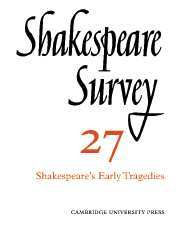Book contents
- Frontmatter
- Shakespeare’s Earliest Tragedies: ‘Titus Andronicus’ and ‘Romeo and Juliet’
- The Aesthetics of Mutilation in ‘Titus Andronicus’
- The Motif of Psychic Division in ‘Richard III’
- The Antic Disposition of Richard II
- The Prince of Denmark and Claudius’s Court
- ‘Hamlet’ and the ‘Moriae Encomium’
- The Relation of Henry V to Tamburlaine
- Shakespeare and the Puritan Dynamic
- Equity, ‘The Merchant of Venice’ and William Lambarde
- ‘Love’s Labour’s Won’ and the Occasion of ‘Much Ado’
- The Date and Production of ‘Timon’ Reconsidered
- Shakespeare, Her Majesty’s Players and Pembroke’s Men
- Judi dench talks to Gareth Lloyd Evans
- Shakespeare Straight and Crooked: A Review of the 1973 Season at Stratford
- The Year's Contributions to Shakespearian Study 1 Critical Studies
- 2 Shakespeare’s Life, Times, and Stage
- 3 Textual Studies
- Index
- Plate section
Shakespeare’s Earliest Tragedies: ‘Titus Andronicus’ and ‘Romeo and Juliet’
Published online by Cambridge University Press: 28 March 2007
- Frontmatter
- Shakespeare’s Earliest Tragedies: ‘Titus Andronicus’ and ‘Romeo and Juliet’
- The Aesthetics of Mutilation in ‘Titus Andronicus’
- The Motif of Psychic Division in ‘Richard III’
- The Antic Disposition of Richard II
- The Prince of Denmark and Claudius’s Court
- ‘Hamlet’ and the ‘Moriae Encomium’
- The Relation of Henry V to Tamburlaine
- Shakespeare and the Puritan Dynamic
- Equity, ‘The Merchant of Venice’ and William Lambarde
- ‘Love’s Labour’s Won’ and the Occasion of ‘Much Ado’
- The Date and Production of ‘Timon’ Reconsidered
- Shakespeare, Her Majesty’s Players and Pembroke’s Men
- Judi dench talks to Gareth Lloyd Evans
- Shakespeare Straight and Crooked: A Review of the 1973 Season at Stratford
- The Year's Contributions to Shakespearian Study 1 Critical Studies
- 2 Shakespeare’s Life, Times, and Stage
- 3 Textual Studies
- Index
- Plate section
Summary
It is commonly accepted that Shakespeare’s earliest essays in tragic form are Titus Andronicus and Romeo and Juliet – accepted, that is, among those who allow that Shakespeare was responsible for Titus Andronicus. But few critics, even among the accepters, seem willing to go beyond the merely chronological point to take up the critical consequence: that we might expect to be able to analyse here an early but characteristic Shakespearian mode of tragedy. The two plays are so obviously unlike one another that it is hard even to think of adding them together to make up any description of a unified mode. Whatever the reason, it is a clear critical fact that these plays are not normally considered together, or even apart, in a description of Shakespearian Tragedy. Shakespeare, it is implied, had to throw away this dispersed prentice work, set it against experience rather than achievement, when he began to compose the sequence of truly ‘Shakespearian’ tragedies beginning with Julius Caesar and growing out of the political interests of the English history plays.
These pre-judgements bear more heavily against Titus Andronicus than Romeo and Juliet, for Romeo has, whatever its generic implication, the refuge of being a 'well-loved' play, where Titus can only be called 'much disliked'. I begin, however, by assuming an equality of interest and importance, taking it that in both plays Shakespeare was writing as well as he knew how. The subsequent reputations of the plays may be thought to tell us more securely about audience preferences in the period between Shakespeare and the present than about the author's intention. My concern in this paper is not with differences of valuation but with the formal similarities and relationships that can be established between the two tragedies.
- Type
- Chapter
- Information
- Shakespeare Survey , pp. 1 - 10Publisher: Cambridge University PressPrint publication year: 1974
- 1
- Cited by



